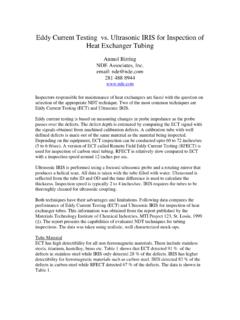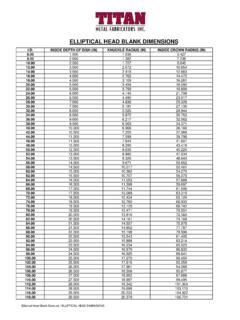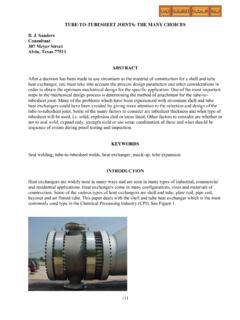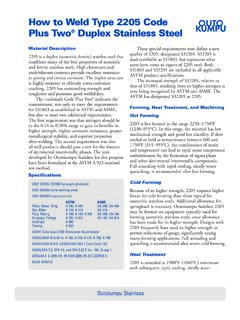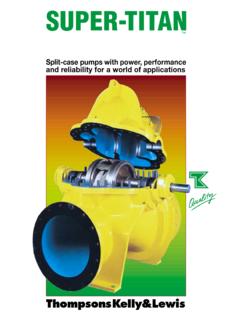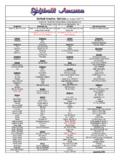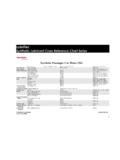Transcription of AL-6XN Alloy - TITAN Metal Fabricators
1 AL-6XN Alloy (UNS N08367)2 Allegheny Ludlum AL-6XN Alloy (UNS N08367) isthe most corrosion resistant iron-base austenitic stain-less Alloy produced by Allegheny Technologies at thistime. It is a low carbon, high purity, nitrogen-bearing"super-austenitic" stainless Alloy . The AL-6XN Alloy wasdesigned to be a seawater resistant material and hassince been demonstrated to be resistant to a broadrange of very corrosive environments. It is readily avail-able from stock in a wide range of product forms, in-cluding thick plate that is suitable for multi-pass weld-ing during field fabrication. The high strength and cor-rosion resistance of the AL-6XN Alloy make it a betterchoice than the conventional duplex stainless steelsand a cost effective alternative to more expensivenickel-base alloys in applications where excellent form-ability, weldability, strength and corrosion resistance areessential.
2 It is also a cost-effective alternative to lessexpensive alloys , such as Type 316, that do not havethe strength or corrosion resistance required to mini-mize life cycle costs in certain high nickel and molybdenum contents provide im-proved resistance to chloride stress-corrosion crack-ing. Copper (Cu) has been intentionally kept to a re-sidual level for improved performance in high Alloy composition of the AL-6XN Alloy re-sists crevice corrosion and pitting in oxidizing chloridesolutions to a degree previously achieved only bynickel-base alloys and Alloy is well suited for such applications as: Chemical process tanks and pipelines Process systems for offshore oil and gas platforms Condensers, heat exchangers and piping containingseawater or crude oil Filter washers, vats and press rolls in pulpbleaching plants Power plant flue gas scrubber environments Tall oil distillation columns and packing Desalination equipment and pumps Service water piping systems for nuclearpower plants Transformer cases exposed to marine environments Pharmaceutical equipment (for product purity) Food processing equipmentAL-6XN Alloy (UNS N08367)
3 CONTENTSI ntroduction and Overview1 Specifications8 Applications10 Corrosion Properties14 Physical Properties26 Mechanical Properties28 Heat Treatment32 Forming34 Welding38 Corrosion of Welds43 Descaling, Pickling and Cleaning46 References49 AppendicesCorrosion Testing AL-6XN Alloy 51 Detention and Removal of Iron in Surface53 Metallography53 Disclaimers54 Index55 2002 Allegheny Ludlum CorporationThe Starburst Logo and AL-6XN areRegistered Trademarks of ATI Properties, Alloy offers the following distinct advantages: Corrosion ResistanceThe intrinsic corrosion resistance of the AL-6XN alloyin both acidic and alkaline environments provides pro-tection against metallic contamination of processstreams and prevents rapid degradation of componentsmade of the Alloy . Cost EffectivenessThe AL-6XN Alloy is often a viable alternative to non-metallic materials that can provide high levels of cor-rosion resistance but are costly to install and Alloy is significantly less costly than mostnickel-base alloys .
4 WorkabilityThe toughness and ductility of the AL-6XN Alloy pro-vide for relative ease of fabrication in the shop or inthe field. The formability and weldability of the AL-6 XNalloy are much better than that of high Alloy ferritic orduplex stainless steels that demonstrate comparableresistance to corrosion. As-Welded PropertiesThe low carbon and high nitrogen contents in AL-6 XNalloy minimize the precipitation of carbides and sec-ondary phases that can occur during welding. There-fore as-welded assemblies can be placed in service,provided that a suitable over-matched filler Metal isused and the assembly has been properly Alloy can be welded in the field using proce-dures similar to those used with other austenitic stain-less steels. Wide Range of Product FormsAL-6XN Alloy is readily available in a wide range ofproduct forms, such as tube, pipe, sheet, plate, bar,billet and forgings.
5 Components such as pumps, valves,fittings, fasteners and castings are also typical and specified chemical compositions ofAL-6XN Alloy are presented in Table 1. The chromium,nickel and molybdenum contents are significantly higherin the AL-6XN Alloy than in the standard Type 304L,316L and 317L grades. The Alloy has the designationUNS N08367 and is included in appropriate standardsin the American Society for Testing and Materials(ASTM) annual book of standards. ASTM initially clas-sified AL-6XN Alloy with the nonferrous alloys in the"B" specification because the Alloy contains slightly lessthan 50% iron. The Alloy is listed with an "N" in theUnified Number System (UNS) for the same compatibility with international standards, ASTMhas changed its definitions for steels and nickel these new definitions, AL-6XN Alloy is now clas-sified as a steel and is listed in ASTM specification A-240 and other "A" specifications.
6 AL-6XN Alloy will,however, remain in the "B" specifications for the fore-seeable low carbon content of AL-6XN Alloy distinguishesit as an "L" grade, providing high resistance to inter-granular corrosion in the as-welded demands placed upon AL-6XN Alloy have becomemore severe, users have demanded that a higher alloyversion of AL-6XN Alloy be produced. Long experi-ence in its production and diligent study of its Metal -lurgy has allowed Allegheny Ludlum to produce anenhanced version of the standard AL-6XN Alloy . Thisenhanced version is called AL-6XN PLUS Alloy . Bothversions satisfy the composition requirements of UNSN08367, but the AL-6XN PLUS Alloy contains agreater concentration of the alloying elements (Cr, Mo,and N) which promote corrosion resistance. This isreflected in the Pitting Resistance Equivalent(PREN = x %Cr + x %Mo + 30 x %N), asshown in Table 1.
7 - AL-6XN PLUS is a Trademark of ATI Properties, PLUS Alloy is custom - melted on an asordered basis, and is not available from CorrosionResistance and StrengthThe goal of the Allegheny Ludlum metallurgists whodeveloped the AL-6XN Alloy was to create an austen-itic stainless Alloy that could be made in all productforms and would be immune to corrosion in stagnantseawater at ambient temperature. When the AL-6 XNalloy is tested in a ferric chloride solution(ASTM G-48B), no signs of crevice attack are observeduntil the solution temperature is increased to 110 F(43 C) or greater - referred to as the Critical CreviceCorrosion Temperature (CCCT), as shown in Table2. This exemplifies excellent resistance to wall thickness of a vessel can sometimes be sig-nificantly reduced with the use of a higher strengthmaterial, such as AL-6XN Alloy .
8 A comparison of theASME data given in Table 3, shows the AL-6XN alloyto exhibit a minimum tensile strength and allowablestresses that are significantly greater than those forType 316L and other stainless steels or high strength of the AL-6XN Alloy is due in partto the interstitial strengthening effect of nitrogen. Thecombined features of increased strength with improvedcorrosion resistance have led to extensive usage ofAL-6XN Alloy in chemical plants and power 1: Chemical Composition (weight %)ChemicalTypicalTypicalElementAL-6XN AL-6XN Plus AlloyAlloyUNS < / / / / 2:Critical crevice-corrosiontemperatures in 10% FeCl3 6H2 OAlloy F CType 31627-3 Alloy 82527-3 Type 317362 Alloy 904L5915 Alloy 22056820E-BRITE 7021 Alloy G8630 Alloy 62510038AL-6XN 11043AL 29-4C 12753 Alloy 27613055 Registered Trademark of ATI Properties, : Values shown are for comparisononly.
9 Always consult current editions of codes andstandards for values for use in data are typical and should not be con-strued as maximum or minimum values for specifica-tion or for final design. Data on any particular piece ofmaterial may vary from those shown DevelopmentThe 18Cr-8Ni austenitic stainless steels have beensuccessfully used in fresh water and mildly corrosiveindustrial conditions for more than 50 years. The cor-rosion resistance, weldability and strength of the aus-tenitic family of alloys have been constantly improvedfor more demanding industrial applications by chang-ing the basic chemical composition. Molybdenum was added to enhance corrosionresistance in chloride environments. Carbon was reduced to avoid sensitization duringwelding. Nitrogen was added to compensate for the reducedstrength of the "L" grades and to improve pittingresistance and phase stability.
10 Chromium was increased to enhance pitting andcrevice corrosion resistance. Nickel was increased to stabilize the austeniticmicrostructure and to improve resistance to generalcorrosion in reducing tubing of the basic 18Cr-8Ni stainless steelcomposition known as Type 304 was first used in the1950s to replace copper-based alloys that had faileddue to ammonia stress-corrosion cracking, erosion bysteam impingement and pitting in acidic river of the initial applications were for Type 304 infresh, industrial and acidic mine waters. More than500 million feet (152 million meters) of Type 304 stain-less steel tubing have been installed in condensers andmost remain in service today. Type 316, which con-tains molybdenum and slightly higher nickel levels, wasused in more corrosive situations. The Alloy contentof Type 316 was found to be too lean to prevent pit-ting and crevice corrosion in certain applications, suchas those involving stagnant seawater.
